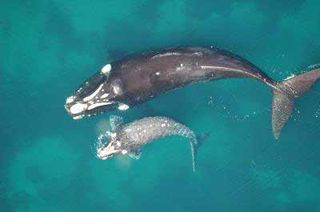Whale Moms Teach Young Where to Eat

Whales are capable of many smart tasks, so it's little surprise that mother right whales teach babies where to go in the vast ocean to find food.
But this discovery, to be published in the Feb. 15 issue of the journal Molecular Ecology, reveals just how tight mother and offspring are.
"Southern right whales consume enormous amounts of food and have to travel vast distances to find adequate amounts of small prey," says study coauthor Jon Seger, professor of biology at the University of Utah. "This study shows that mothers teach their babies in the first year of life where to go to feed in the immensity of the ocean."
The study tracked how whales are related by analyzing maternal DNA, and then compared that with dietary information obtained by characterizing different forms or isotopes of chemical elements in their skin. The two techniques – which the researchers say they used together for the first time – allowed the scientists to determine that whale mothers, their offspring and other extended family members eat in the same place.
"North Atlantic right whales feed in similar patterns and scientists have access to their feeding areas, but we don't know where South Atlantic whales are feeding, so we had to use a combination of techniques to track this down," says Luciano Valenzuela, a postdoctoral researcher in biology who led the study as part of his doctoral thesis at Utah.
Adult southern right whales are up to 50 feet long, and their calves are about 20 feet long and weigh a ton at birth.
The whales migrate to their calving grounds in winter, when they fast, and give birth in early spring. Three months later, they travel long distances in the South Atlantic to feed for the remainder of the year on krill and on other crustaceans named copepods.
Sign up for the Live Science daily newsletter now
Get the world’s most fascinating discoveries delivered straight to your inbox.
During September and October of 2003 through 2006, Valenzuela collected small skin samples using a punch device that doesn't harm the animals.
"The skin sample is a little bigger than the size of a pencil eraser," Rowntree says.
From the skin samples, Valenzuela analyzed mitochondrial DNA, which is inherited only from the mother. The DNA revealed family relationships among whales. The researchers were able to distinguish individual whales by the patterns of whitish, callous-like material on their heads.
The skin samples also were analyzed for different forms or isotopes of carbon and nitrogen. The isotopes, which are present in food, are deposited in different tissues of the body after consumption. Food from any given location has a unique isotope "signature." That made it possible to determine which whales fed in the same place without actually knowing where the feeding areas were.
Together, the DNA and isotope data revealed which whales were related and where each animal fed.
"The main result is that individuals from particular families have very specific isotope pattern showing that animals from specific lineages feed in the same area," Valenzuela says.
Because the DNA was mitochondrial, which is passed only from mothers to offspring, the findings indicate mother whales teach their calves where to feed.
- Whale News and Information

